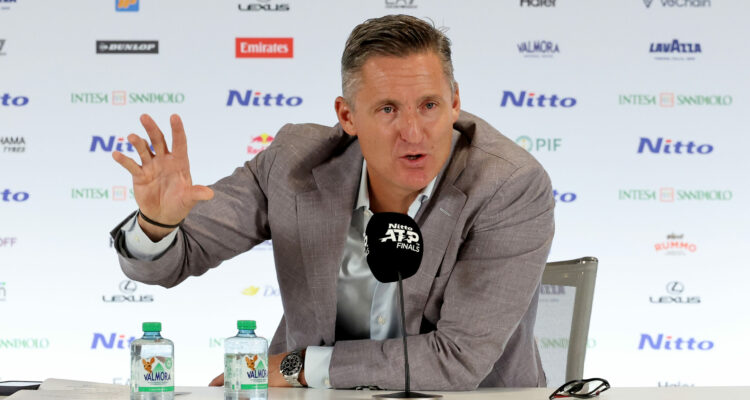TURIN/WASHINGTON, November 14, 2025 (by Michael Dickens)
As the Nitto ATP Finals reaches a fitting climax this weekend, with the possibility of a marquee match-up final between World No. 1 Carlos Alcaraz and World No. 2 Jannik Sinner, ATP Chairman Andrea Gaudenzi said that the current (fifth) edition of the year-end tournament in Turin, Italy has been nothing short of amazing.
“I think every single year the event has improved,” Gaudenzi said during a news conference Thursday at Inalpi Arena. “Kudos to the FITP (Federazione Italiana Tennis e Padel), they’ve done an incredible job. I think we were all a bit anxious post London, because London was [a] great event. I think we’ve delivered and were are above the expectation we had initially.
“Obviously it’s super exciting to have the best players in the world fighting for the No. 1 at the end of the year. I think this is probably the best possible outcome. It’s great for the fans. It’s great for everybody watching the final showdown.”
While Gaudenzi confirmed that the 2026 edition of the ATP Finals would take place in Turin – the city is currently under contract to hold the ATP Finals through 2030 – he said nothing has been decided yet about remaining in the northern Italian city beyond next year. “We are very satisfied with Turin but we will sit down to evaluate with the FITP at the beginning of next year,” he said.
ATP Chairman Andrea Gaudenzi and Carlos Alcaraz at the ceremony recognising the Spaniard’s ATP Year-End No. 1 presented by PIF honour. #PIF | #ATPRankings | #partner | #NittoATPFinals
— ATP Tour (@atptour) November 14, 2025
During a Q & A session with tournament media, Gaudenzi addressed a variety of questions pertaining to the future make-up of the ATP Tour calendar, especially with the arrival of a 10th Masters 1000 event in Saudi Arabia in 2028. He said that he anticipates changes in tennis. Namely, there will be fewer small tournaments (250s) in the future and a longer off-season is necessary for the health and well-being of players. However, he noted, the 12-day Masters 1000s concept that was initiated this year in tournaments held in Madrid, Rome, Canada, Cincinnati and Shanghai will continue.
“Tennis is a very, very, very difficult sport to schedule, probably the hardest, for a simple reason: it is direct elimination,” Gaudenzi said. “Look, for example, in a Grand Slam or in a 12-day event, a player can play one match one day or they can play seven matches 12 days. You even look at golf, for example, the top 60 players, they play the 72 holes over four days. You have a cohort of players, the top 100, where you go from the top to the bottom, where you have Carlos and Jannik now playing around, I would say, 80 matches within 18, 20 tournaments. Then obviously the lower-ranked, they play 30, 35 tournaments, a lower amount of matches.
“You’re trying obviously with at least one calendar, but in reality you have four, five calendars within one calendar. I was one of those players that most of the time was losing first or second round (smiling), because half of the players lose first round, and 75 percent of the players are done by the second round. For most of them is a two- or four-day event. For others, it’s a longer event. This is just to highlight the complexity of the calendar.
“Obviously there are different cohort of players saying it is too much. For others, if you remove, it becomes too less for the others because they need to play. If you lose, you have to go to another tournament and play more matches. That’s why we have the different tiers and categories: Grand Slams, Masters, 500 and 250.
“We try to balance it for all the cohort of players, including challengers, because the challengers also very important for the pathway and to build the champions of the future.”
Gaudenzi confirmed that “the goal looking towards 2028, with the Masters 1000 in Saudi Arabia, is to reduce the number of 250 tournaments.
“For the ATP 250s, there’s a strategy to reduce them from 38 to 29, and with the arrival of the new Saudi Masters, there’s goal is 28,” he said.
“250s are very important, like challengers and 500. Every category is important. But we had a bit too many of them. Was really difficult to schedule within the calendar.”
One thing Gaudenzi noted about the complex challenges of shaping the tennis calendar is the number of different competing groups – ATP, WTA and ITF plus the four Grand Slams – who want to have an equal voice in matters.
“Seven different entities affect this global calendar,” Gaudenzi said. “I have a lot of sympathy for the players who have to relate to seven different entitles that decide on the dates. This is why my One Vision plan aims to unify governance to create a more rational schedule. However, the priority is the premium product – Masters and Finals – because the fans want to see the best [players] in the most important tournaments.
“The fans love to watch the best players in the world player against each other in the best events. Those moments, like the four Grand Slams, the Masters and the Finals, is the moment we all get to see the best players playing against each other.”
With regards to the ideal numbers of weeks of off-season for the players, Gaudenzi said: “Some would like six weeks, others seven, others eight. Surely, a player needs a one-two weeks of real break, then one-two weeks of athletic preparation before resuming the racquet.
“The off-season must be longer than the current one. However, it depends on the level. Those who end up in Paris often already go on vacation, while the Top 8 continue with the Finals and now also Davis Cup.
“For me, the Davis Cup is an exceptional event and the home-away format created a unique atmosphere. Playing it every year is complicated. The ideal would be a two-year cadence, like a World Tennis Championship, with a season that leaves more flexibility to the top players. I think it will be needed at least seven weeks of off-season.”





